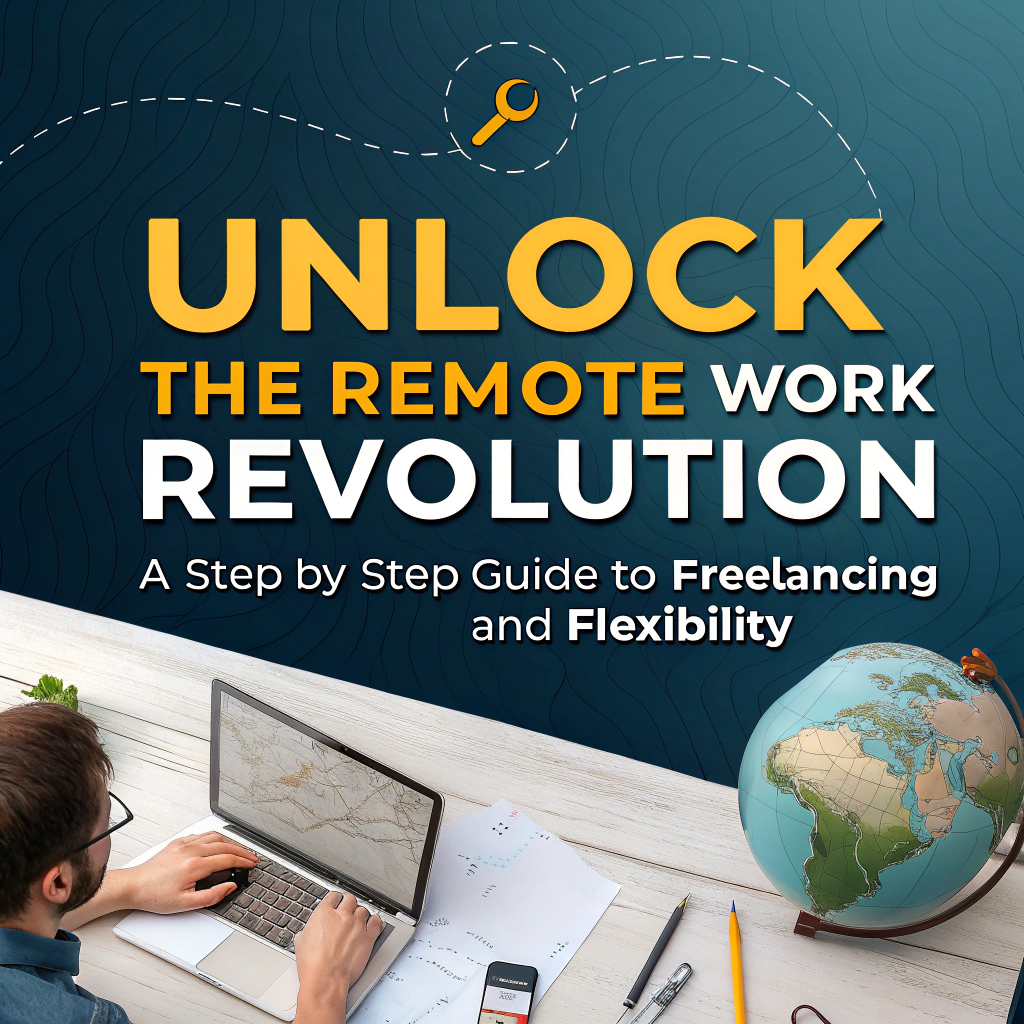Unlock the Remote Work Revolution A Step by Step Guide to Freelancing and Flexibility

Do you know what is crazy? Just 5 years back, if you had told your boss that you wanted to work from your kitchen table and in your pajamas, he would have probably thrown a fit and maybe even laughed you out of the office. Today a remote working is not only accepted but also the new normal. The truth is the pandemic didn’t make remote work; it just gave it a quick ramp up.
Let’s talk about something that has completely changed our views on careers, freedom, and success. This isn’t just another “work from home” guide. What we mean is a lifestyle that allows you to be the master of your time, place, and money. Too good to be true? Keep reading
The Remote Work Revolution: More Than Just a Trend
Do you remember when the expression “going to work” really meant wearing your least favorite piece of clothing and sitting in the traffic for an hour? Those days seem like a thing of the past now, don’t they? The remote work revolution has changed the whole world to the extent that people now deal with productivity, success, and work, life balance in new ways.
One thing is for sure remote work is not solely working from your house. It is a concept of working from anywhere. Your neighborhood coffee shop, a Bali beach, your parent’s house during the holidays, or even the cabin you’ve always dreamed of a visit, the only limitation is your imagination.

By the way, let’s bust a common myth right now, Remote work doesn’t mean being lazy or less productive, Studies consistently show that remote workers are often more productive than their office bound counterparts, Why? Because they’re not dealing with office distractions, lengthy commutes, or the dreaded “let’s have a meeting about our meeting” culture.
Why Freelancing Is Your Gateway to Freedom
Freelancing is like having a master key to the remote work kingdom, Unlike traditional remote employees who still answer to one boss, freelancers get to choose their clients, set their rates, and design their own schedules, It’s the ultimate expression of professional freedom.
Let me tell you about Sarah, a graphic designer I know, Two years ago, she was stuck in a 9 to 5 job, earning a fixed salary, and feeling creatively stifled, Today? She’s working with clients from three different continents, earning 40% more than her old job, and taking month long vacations whenever she wants, That’s the power of freelancing.
But here’s what most people don’t realize freelancing isn’t just for creative types anymore, You can freelance in almost any field:
- Digital marketing and social media management
- Content writing and copywriting
- Web development and programming
- Virtual assistance and project management
- Consulting and coaching
- Online tutoring and course creation
- E Commerce and dropshipping
The opportunities are practically unlimited.
Step 1: Discovering Your Freelance Sweet Spot
Before you can unlock the remote work revolution, you need to figure out what skills you’re going to sell, This isn’t about finding the “perfect” niche it’s about finding Your perfect niche.
Start by asking yourself these questions:
What are you naturally good at? Maybe you’re the person everyone comes to for tech help, or you have a knack for explaining complex things in simple terms, These natural abilities are goldmines
What do you enjoy doing? This matters more than you think, If you hate writing, don’t force yourself into content creation just because it’s popular, Find something that energizes you
What problems can you solve? Every successful freelancer is essentially a problem solver. What problems do you see people struggling with that you could help fix?

Let’s dive deeper into skill assessment, Create a list of everything you’re good at don’t filter anything out yet, Include soft skills like communication, hard skills like Excel mastery, and everything in between, You might be surprised what’s valuable in the freelance market.
For instance, being organized might seem basic, but virtual assistants who excel at project management can earn $25 to 50 per hour, Speaking multiple languages? Translation services are always in demand, Good at explaining things? Online tutoring is booming.
Step 2: Building Your Freelance Foundation
Once you’ve identified your skills, it’s time to build your freelance foundation, Think of this as constructing the bedrock of your new remote career.
Starting with the Basics:
- professional email Address (stop using the old account from high school)
- LinkedIn profile that truly reflects your abilities
- Easy website or portfolio, if it’s only a page
- The same professional photo on different platforms
Set Up Your Digital Workspace
Working remotely requires the right tools, You don’t need to break the bank, but you do need reliable equipment:
- Decent computer and internet connection
- Noise canceling headphones for client calls
- Good lighting for video meetings
- Backup plans for internet outages

Legal and Financial Setup
This might sound boring, but getting your business basics right from the start will save you headaches later:
- Register your business name if needed
- Set up separate business banking
- Understand tax implications
- Get basic insurance if applicable
Step 3: Finding Your First Clients
Here’s where the rubber meets the road, Finding clients can feel intimidating, but remember businesses need what you’re offering, Your job is to connect the dots.
Start with Your Network
Before you start cold pitching strangers, look at who you already know, Friends, family, former colleagues, and acquaintances are often your first and best clients, They already trust you, which is half the battle.
Send a simple message like: “Hey! I’m starting a freelance business doing [your service], Do you know anyone who might need help with “specific problem you solve?”
Leverage Freelance Platforms
While you shouldn’t rely entirely on platforms like Upwork Fiverr, or Freelancer, they’re great for building initial experience and testimonials, Yes, the competition is fierce, but if you position yourself correctly, you can stand out.
Tips for platform success:
- Write proposals that focus on the client’s needs, not your qualifications
- Start with smaller projects to build reviews
- Always deliver more than promised
- Treat every client interaction as professional development
Direct Outreach That Works
Once you’re ready to move beyond platforms, direct outreach becomes your secret weapon But please, don’t send generic “Dear Sir/Madam” emails That’s the fastest way to the trash folder.
Instead, research companies that could use your services and send personalized messages that demonstrate value, Here’s a formula that works:
- Specific compliment about their business
- Observation about a problem you could solve
- Brief suggestion for improvement
- Clear call to action

Step 4: Mastering Remote Work Productivity
Working from anywhere sounds amazing until you realize “anywhere” includes your couch, where Netflix is just a click away, Remote work productivity isn’t about being superhuman it’s about creating systems that work for you.
Design Your Ideal Work Environment
Your terrain shapes your mindset. Whether you are working from home, a coffee shop, or a co-working space, certain rudiments boost productivity
- devoted workspace, indeed if it’s just a corner of your kitchen table
- Good lighting( natural light is stylish)
- Comfortable seating that supports good posture
- minimum distractions within your line of sight
Master Your Time Management
Time management as a freelancer is different from regular employment,You’re not just managing your time you’re managing multiple clients, projects, and deadlines simultaneously.
- Try the time locking method:
- Block specific hours for deep work
- Schedule shorter blocks for admin tasks
- Leave buffer time between calls
- Batch similar activities together
The Pomodoro Technique is also gold for remote workers. Work for 25 minutes, take a
5 inute break, and repeat,It sounds simple, but it’s incredibly effective for maintaining focus.
Communication Is Everything
In remote work, over communication beats under communication every time,Your clients can’t see you working, so you need to make your progress visible.
- Send regular project updates, even if there’s no major news
- Respond to messages promptly
- Be proactive about potential delays or issues
- Use video calls when possible it builds stronger relationships

Step 5: Scaling Your Remote Work Success
Once you’ve got your first few clients and established a routine, it’s time to think bigger,Scaling doesn’t just mean earning more money (though that’s nice too) It means creating a sustainable business that gives you the freedom you’re after.
Raise Your Rates Strategically
Here’s something nobody tells new freelancers: you should be raising your rates regularly,Not because you’re greedy, but because your skills improve, your experience grows, and your value increases.
Start tracking:
- How long projects actually take you
- Which types of work you enjoy most
- Which clients are easiest to work with
- What problems you solve most effectively
Use this data to justify rate increases, Most freelancers undervalue their services initially Don’t stay stuck there.
Build Recurring Revenue
One off projects are great, but recurring clients are the holy grail of freelancing
They provide predictable income and reduce the constant stress of finding new work.
Ways to create recurring revenue:
- Monthly retainer agreements
- Ongoing maintenance contracts
- Subscription-based services
- Long term project partnerships
Develop Multiple Income Streams
The most successful remote workers don’t rely on just one type of income, They diversify This might include:
- Client work (your main focus initially)
- Digital products or courses
- Affiliate Marketing
- Passive income investments
- Speaking or consulting fees

The Financial Side: Making Remote Work Profitable
Money talk makes some people uncomfortable, but let’s address the elephant in the room. Remote work should improve your financial situation, not strain it.
Understanding Your True Hourly Rate
When you’re freelancing, your rate isn’t just what you charge clients. You need to account for:
Time spent finding new clients
- Administrative tasks
- Professional development and skill building
- Equipment and software costs
- Taxes and business expenses
A good rule of thumb: if you want to make $50,000 per year as a freelancer, you need to charge rates that would generate around $75,000 in billable work, accounting for non billable time and expenses.

Building Financial Stability
Freelance income can be unpredictable, especially starting out, Build stability by:
- Maintaining 3 to 6 months of expenses in savings
- Diversifying your client base
- Creating predictable income streams
- Planning for seasonal fluctuations in your industry
- Setting aside money for taxes quarterly
Tracking Everything
You can’t manage what you don’t measure Track:
- Time spent on each project
- Actual vs. estimated project duration
- Client acquisition costs
- Monthly recurring revenue
- Business expenses for tax purposes
Building Long Term Success
Remote work isn’t just about escaping the traditional office it’s about building a sustainable career that evolves with your life goals.
Continuous Learning and Adaptation
The remote work landscape changes rapidly, Skills that are in high demand today might be automated tomorrow, Stay ahead by:
- Following industry trends and news
- Investing in online courses and certifications
- Experimenting with new tools and technologies
- Building relationships with other professionals in your field
Creating Your Professional Network
Networking as a remote worker requires intentional effort, but it’s crucial for long term success:
- Engage actively on social media platforms like LinkedIn and Twitter
- Attend virtual conferences and webinars
- Join professional associations in your field
- Participate in online forums and discussion groups
Planning for Growth
Where do you want your remote career to be in five years? Maybe you want to:
- Build a team and run a remote agency
- Become a recognized expert in your niche
- Create passive income streams that reduce client dependence
- Travel the world as a digital nomad
- Achieve complete financial independence
Frequently Asked Questions
Q: How long does it take to build a successful freelance business? A: Most freelancers see steady income within 6 to 12 months, but it varies greatly depending on your skills, market demand, and how much time you dedicate to building your business, Some see success in 3 months, others take 2 years.
Q: Do I need special education or certifications to start freelancing? A: Not necessarily While some fields require specific credentials, many successful freelancers succeed based on skills, experience, and results they deliver to clients, Focus on building a strong portfolio and gathering testimonials.
Q: How much money can I realistically make working remotely? A: Remote work income varies enormously, Entry level freelancers might start at $15 to 25/hour, while experienced specialists can charge $100+/hour, The key is building valuable skills and positioning yourself strategically in the market.
Q: Is remote work suitable for people with families? A: Absolutely Many parents choose remote work specifically for the flexibility it provides, However, it requires good boundary setting and potentially childcare during work hours, especially for client facing work.
Q: What equipment do I need to start working remotely? A: Basic requirements include a reliable computer, stable internet connection, and quiet workspace, Specific needs vary by industry, but most people can start with equipment they already have.
Your Next Steps: Taking Action Today
Okay, so you’ve read this far, That means you’re serious about unlocking the remote work revolution, But here’s the thing information without action is just entertainment, It’s time to move.
This Week:
- Complete the skill assessment exercise above
- Set up your professional email and LinkedIn profile
- Research 10 companies in your area who might need your services
- Join one online community for remote workers in your field
This Month:
- Create your basic portfolio or website
- Send your first five outreach emails
- Apply for three projects on freelance platforms
- Set up your basic business structure
This Quarter:
- Land your first paying client
- Complete three successful projects
- Ask for testimonials and referrals
- Refine your service offerings based on market feedback
The Bottom Line: Your Freedom Awaits
The remote work revolution isn’t coming—it’s already here. The question isn’t whether remote work will be part of the future; it’s whether you’ll be part of that future.
You have everything you need to start this journey. The skills in your head, the technology at your fingertips, and now the roadmap to success. What you do with this information is entirely up to you.
According to Wikipedia, the rise of remote work has transformed industries worldwide, creating opportunities that were unimaginable a decade ago. Similarly, Careerizo highlights that success in this space depends not only on technical skills but also on adaptability, discipline, and the willingness to take action.
Remember, every expert was once a beginner. Every successful remote worker started with that same mixture of excitement and nervousness you might be feeling right now. The difference between those who succeed and those who stay stuck isn’t talent or luck—it’s action.
The remote work revolution is about more than just changing where you work. It’s about reclaiming control over your life, your time, and your future. It’s about proving that success doesn’t require sacrificing your personal life or conforming to outdated workplace traditions.
Your flexible, profitable, location-independent career is waiting. The only question is: when will you start building it?
Ready to take the first step? Start with our skill assessment today, and begin building the remote career you’ve always dreamed of, The revolution has begun don’t get left behind.

